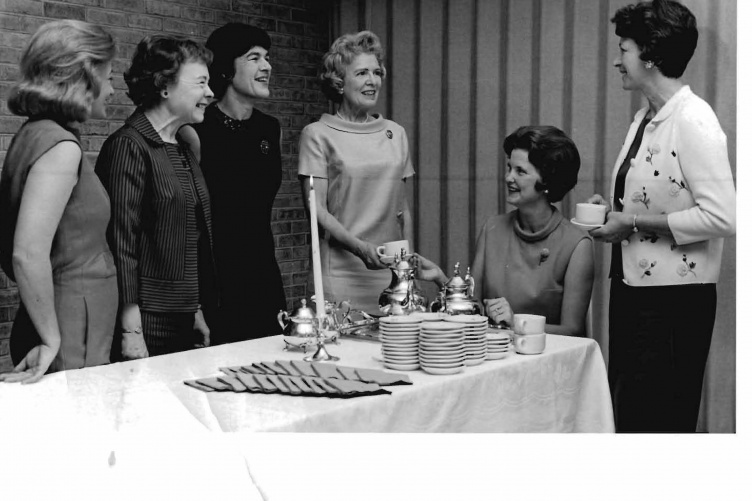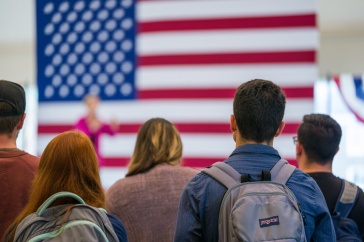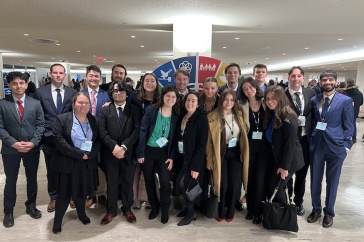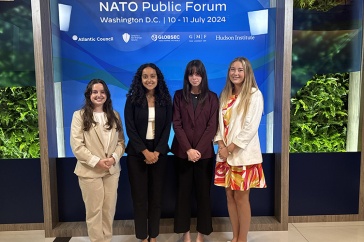
Mrs. Mary Polasky (second from right), president of the Ann Arbor, Michigan, League of Women Voters (1967) and mother of history professor Janet Polasky.
To help pay for her college education, Carrie Chapman Catt worked as a dishwasher, in the school’s library and as a teacher in rural schools. When she graduated from Iowa University in 1880, she was the only woman in her class.
Catt went on to become San Francisco’s first female reporter and later, the first superintendent of schools in Mason City, Iowa. But her passion belonged to the women’s suffrage movement. Catt is credited with implementing a state-by-state plan to gain support for women’s right to vote and twice served as president of the National American Woman Suffrage Association. Then, on Feb. 14, 1920, six months before the 19th Amendment was ratified, she founded the League of Women Voters (LWV).
Catt saw the new bipartisan organization, referred to at the time as “a mighty political experiment,” as a way to unite women and educate them on issues they would face at the ballot box. Addressing local and national issues, the league adopted 69 goals during the first year alone, covering such areas as education, morals, gainful occupations for women and the high price of homes, among others.
“We haven’t marched in recent history, but if the issue came up, I can’t say we won’t.”
“The League of Women Voters was a pretty radical organization in the '20s,” says history professor Janet Polasky. “They were saying it was to educate women on voting, but they were working on other issues as well — child welfare, public health, independent citizenship for married women. Those were not small goals.”
The LWV encouraged government involvement with “Know Your Town” surveys and candidate questionnaires. In 1928, they sponsored “Meet the Candidates,” the first national radio broadcast of a forum introducing candidates to the public.
“The League of Women Voters had a real role in helping women understand how to participate in the public sphere of politics when they previously had been relegated to the private, domestic sphere,” says Emily Baer-Bositis, assistant professor of political science. “During the early years after suffrage, the national and state organizations taught women about the rights, opportunities and obligations afforded to them as citizens. League meetings gave women a safe space to learn how to discuss and deliberate on public policy issues – and ultimately, to develop the skills necessary to participate in a democracy.”
The league lost some of its momentum, however, during the Great Depression, and chapters across the country began dying out. According to the LWV, between 1924 and 1934, membership fell from 100,000 to 44,000. The onset of WWII brought gas rationing, leading women to meet in their neighborhoods and communities rather than traveling afar. Meanwhile, league members worked to help establish the United Nations. They also supported the creation of the World Bank, the International Monetary Fund, NATO and the Marshall Plan.
Membership rose again in the 1950s. Polasky recalls her own mother’s involvement with the LVW; she became president of the Ann Arbor, Michigan league in 1967. At the time, many of the members were traditional housewives. Polasky’s mother had wanted to join the foreign service; she ended up having three children before that could happen.
“My mother had been involved in politics and the league became her outlet," Polasky says. “There were other women like her, who had so much to give. The league just took that energy and found a way to make it work for them.”
On a local level, that work involved a study of long-term planning for the Ann Arbor area and an evaluation of housing and medical care facilities, according to a newspaper article from May 4, 1967 that announced Mrs. Alan Polasky as the newly elected president. In the accompanying photo, she is seen pouring tea for other members. Similar photos appeared in papers around the country.
“All these women pouring tea appeared so nonthreatening, but they were not shrinking from anything,” Polasky says. “In some ways, so many of the issues we view as cutting-edge today, the League of Women Voters were already doing. I remember hearing discussions on how to get fair housing; how to get bus service so people could get to work; civil rights.”
And she recalls a later newspaper piece where her mother discussed issues that hadn’t yet gained the support the local LWV sought. “We haven’t marched in recent history, but if the issue came up, I can’t say we won’t,” Mary Polasky was quoted as saying.
In 1974, the League of Women Voters, which has local, state and national groups, made the decision to allow men to join the organization. Two years later, they sponsored the first presidential debates since 1960 and won an Emmy for their efforts.
“One of the things that is especially unique about the league is its complete commitment to non-partisanship. It’s important to remember that one of the primary strategies employed by suffragettes in the early 20th century was endorsements of Republican and Democratic candidates for office who supported women’s right to vote – an explicitly partisan act,” Baer-Bositis says.
“In the aftermath of the 19th Amendment, the two parties saw the National League of Women Voters as an independent electoral threat,” she says. “Some were even fearful that the league (and other women’s organizations) would ultimately develop into their own independent ‘women’s party’ rooted in ‘gender solidarity.’ This electoral threat incentivized the two parties to create leadership opportunities for women within their own ranks – positions that still exist today in both the Democratic National Committee and the Republican National Committee.”
-
Written By:
Jody Record ’95 | Communications and Public Affairs | jody.record@unh.edu

















































